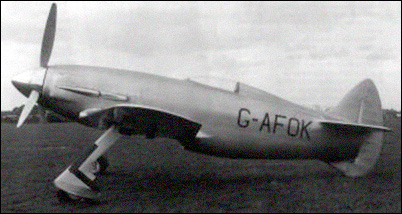| Terrence I. Murphy, e-mail, 10.02.2012 18:29 The Napier-Heston Racer, also referred to as the Heston Type 5 Racer was a 1940s British single-seat racing monoplane first conceived by D. Napier and Son Ltd., and built by the Heston Aircraft Company Ltd, for an attempt on the World Air Speed Record
It was a single-engined, low-wing cantilever monoplane, purpose-built as a contender for the World Speed Record. It was built almost entirely of wood that served to ensure rapid construction, a "superfine" finish, and streamlined, "beautiful" lines. The use of a multi-ducted belly scoop and clear, low profile perspex canopy, along with a reputed 20 coats of hand-rubbed lacquer also contributed to the sleek aerodynamic finish. Saunders-Roe provided wing spars made of "Compregnated wood", a system that involved multiple laminations bonded with resin under high pressure.
Diminutive, thin-sectioned symmetrical wing airfoils were designed for high-speed flight. The elevator control circuit was designed by Heston Aircraft Company's Chief Draughsman, C.G.W Ebbutt, with a variable ratio- with the stick near the neutral position, large movements could be made with small resulting pitch movements. This was needed for accurate handling at low level and high speed (the 3 km airspeed record course had to be flown less than 100ft above sea level). Towards the ends of the control column movement, the ratio increased to allow utilization of the full range of elevator travel.
The aircraft's design parameters were purposely designed around a top secret, untested, 24-cylinder, 2,450 hp liquid-cooled Napier Sabre engine.
The first aircraft of two planned for the record attempt had its maiden flight at the Heston Aerodrome on 12 June 1940, piloted by Squadron Leader G.L.G. Richmond, Chief Test Pilot of Heston Aircraft. The takeoff was not without drama and a heavy bump during the high speed run in takeoff configuration (with the constricted canopy removed for the test flight), launched the Racer prematurely into the air.
Recovering from the abrupt takeoff, Richmond carried out a preliminary test flight with gear extended throughout but after only five minutes airborne, while encountering inadequate elevator control, the engine overheated. According to some accounts, Richmond was being scalded by steam from the radiator mounted below the cockpit, and in haste to carry out a forced landing, inadvertently stalled the aircraft at approximately 30 ft above the airfield. Other sources state that the coolant leak only occurred after impact The aircraft impacted heavily, with the undercarriage driven through the wings, and the tail broken off.
Napier had ordered two examples in 1938, but with the destruction of the first prototype, the Napier-Heston program was discontinued despite 80% completion of the second aircraft.
General characteristics
• Crew: One
• Length: 24 ft 7¼ in (7.50 m)
• Wingspan: 32 ft 0½ in (9.766 m)
• Height: 11 ft 10 in (3.61 m)
• Wing area: 167.6 ft2 (15.57 m2)
• Gross weight: 7,200 lb (3,266 kg)
• Powerplant: 1 × Napier Sabre H-24 cylinder liquid-cooled piston engine, 2,450 hp (1,828 kW) each reply |









